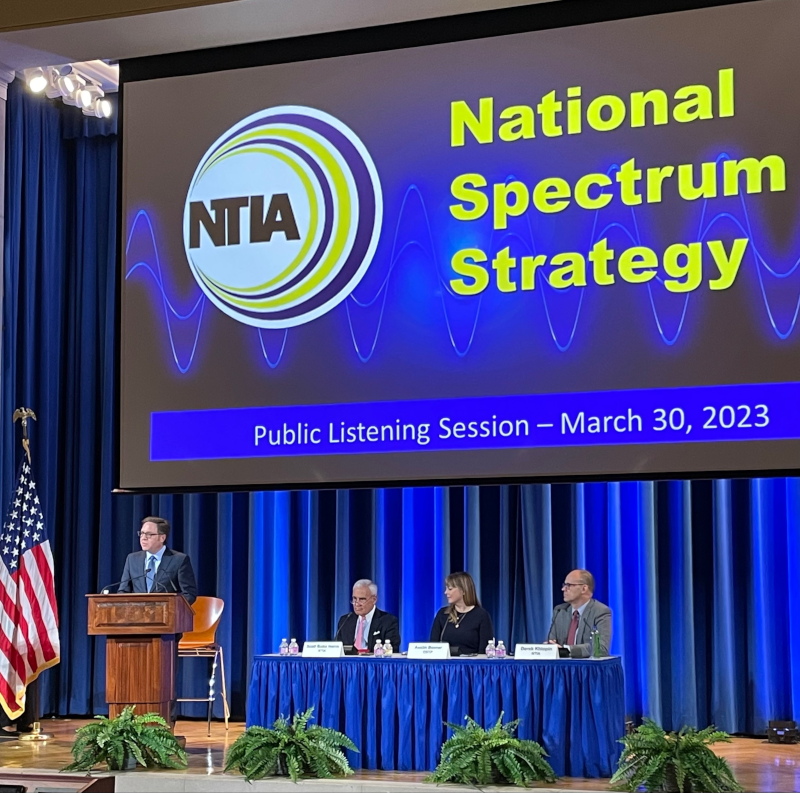As required by the Presidential Memorandum titled Modernizing United States Spectrum Policy and Establishing a National Spectrum Strategy, the Secretary of Commerce, through the National Telecommunications and Information Administration (NTIA), prepared this National Spectrum Strategy to both promote private-sector innovation and further the missions of federal departments and agencies, submitting it to the President through the Assistant to the President for National Security Affairs, the Assistant to the President for Economic Policy, and the Director of the Office of Science and Technology Policy.
The Strategy reflects collaboration with the Federal Communications Commission (FCC), recognizing the FCC’s unique responsibilities with respect to non-Federal uses of spectrum, and coordination with other Federal departments and agencies (referred to collectively here as “agencies”). In carrying out this task, NTIA conducted extensive public outreach through a request for comment, two public listening sessions, two Tribal Nation consultations, and one-on-one meetings with stakeholders. NTIA has made this information, as well as supplemental comments filed by stakeholders, publicly available. NTIA also sought and received written comments and guidance from Federal agencies and hosted a Government-only listening session to gather additional feedback.
The result is a comprehensive strategy to modernize spectrum policy and make the most efficient use possible of this vital national resource to enhance the quality of life for all Americans. This Strategy will expand access to advanced wireless broadband networks and technologies, whether terrestrial-, airspace-, satellite- or space-based, for all Americans. And it will
- drive technological innovation (including innovative spectrum sharing technologies);
- boost U.S. industrial competitiveness;
- protect the security of the American people;
- foster scientific advancements;
- promote digital equity and inclusion;
- and maintain U.S. leadership in global markets for wireless equipment and services, as well as innovative spectrum-sharing technologies,
all essential priorities for the Biden-Harris Administration.
Overview
Radio frequency spectrum plays a significant—but often unacknowledged—role in Americans’ daily lives. The radio waves that carry data and voice communications to smartphones and other devices are, after all, invisible. But consumers, businesses, and governments at every level rely upon spectrum to complete a significant, untold number of tasks, from the mundane to the critical.
Indeed, wireless services have become essential for citizens to function in the 21st Century. Wireless connectivity provides increasingly reliable and affordable high-speed internet access, helping to eliminate coverage gaps and to enable diversity, equity, and inclusion for all Americans, even in hard-to-reach areas, including Tribal Nations, underserved communities, and U.S. territories. Wireless capabilities also have become integral to public safety, medical care, education, multimodal transportation, and an array of industrial operations. Critical U.S. Government services and missions also increasingly depend on spectrum access. Essential government missions rely on wireless systems on the ground, in the air, at sea, and in space to protect our national security and to provide services that deliver important public benefits.
As a result of ongoing innovations in wireless technologies, demand for spectrum access is growing rapidly. In the private sector, next-generation Wi-Fi networks, large satellite constellations in low-Earth orbit, rapidly increasing space launch cadences, aggregated data transfer requirements, 5G and 6G broadband networks, private wireless networks, autonomous vehicles, and other advanced systems drive demand. Dynamic spectrum sharing is one key to meet these growing demands, and the United States is uniquely positioned to embrace a whole-of-Nation approach to advance the state of technology for dynamic forms of sharing.
The United States needs a comprehensive strategy to modernize spectrum policy and make the most efficient use possible of this vital national resource.
In general, technological innovations in communications, passive sensors, radars, and other applications are integral to the Federal Government’s priorities for national security, critical infrastructure, transportation, emergency response, public safety, climate monitoring, weather forecasting, scientific discovery, and economic growth. A growing number of applications and technologies, such as Global Navigation Satellite Systems (GNSS) (including the Global Positioning System or GPS), serve both governmental and nongovernmental users. All of these uses and spectrum demands are important to the Nation and must be protected from harmful radio frequency interference to ensure a high level of service availability and to best serve the public interest. Yet spectrum access is not unlimited, which increases the importance of embracing opportunities to expand dynamic spectrum access for all users.
This Strategy draws heavily upon the information received during NTIA’s outreach efforts. It represents a high-level blueprint that articulates our national objectives for spectrum policy and charts a whole-of-Nation approach to achieving those objectives. The Strategy recognizes that its implementation must be consistent with, and in no way limit,
- the FCC’s statutory role as an independent agency that is the exclusive regulator of non-Federal spectrum use; or
- NTIA’s statutory role as the sole agency responsible for authorizing Federal spectrum use.
The Strategy further recognizes the statutory roles and responsibilities of Federal agencies to carry out missions that rely on spectrum access.


